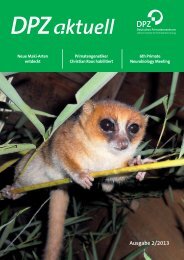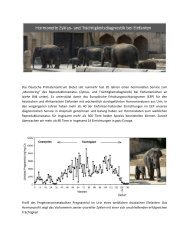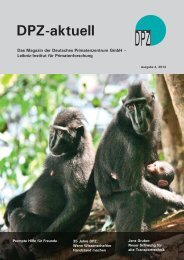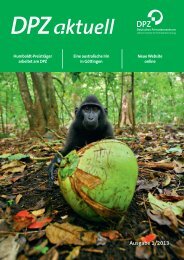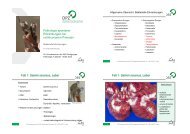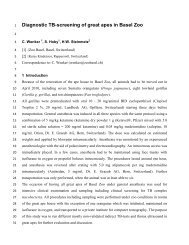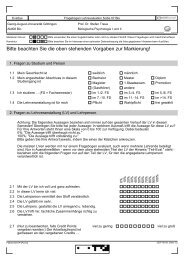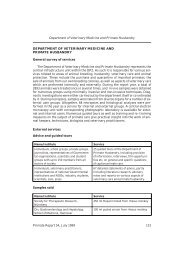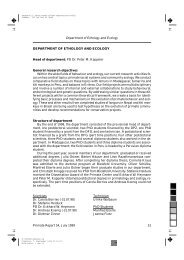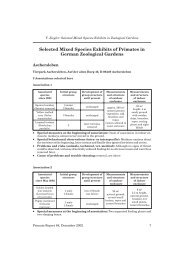Vol. 15 - Deutsches Primatenzentrum
Vol. 15 - Deutsches Primatenzentrum
Vol. 15 - Deutsches Primatenzentrum
You also want an ePaper? Increase the reach of your titles
YUMPU automatically turns print PDFs into web optimized ePapers that Google loves.
Lemur News <strong>Vol</strong>. <strong>15</strong>, 2010 Page 31<br />
Discussion<br />
The parcel of Ivontaka Nord is considered to be an example<br />
of disturbed primary forest.Anthropogenic effects are much<br />
stronger in Ivontaka Nord than in other parcels,because it is<br />
the smallest of the three, and the closest to the town of<br />
Mananara. Before the creation of the national park, the area<br />
of Ivontaka Nord was frequently used as a place to grow<br />
crops through tavy,harvest wood for construction and cooking,and<br />
hunt lemurs.For these reasons,the lemur population<br />
of the parcel was at one time diminished to the point of localized<br />
extinction of the critically endangered Varecia v.variegata,<br />
in addition to the localized extinctions of Indri indri and Hapalemur<br />
griseus (J. Betsiahilika, personal communication). Yet,<br />
because it is connected through a corridor of community<br />
managed forest to the less disturbed parcel of Ivontaka Sud<br />
(Fig.1),in 2002,V.v.variegata migrated into the GCF corridor<br />
between Ivontaka Sud and Ivontaka Nord, and in 2005 these<br />
lemurs could again be found within the parcel. However, the<br />
species of Indri indri and Hapalemur griseus are not believed to<br />
currently inhabit the parcel, though they can be found in the<br />
other two parcels within the biosphere (J. Betsiahilika, personal<br />
communication).<br />
Within the parcel, there was convincing evidence to suggest<br />
that the lemurs might be recovering even more than previously<br />
known. During the two weeks of transects, Eulemur<br />
rubriventer was observed within the parcel, even though its<br />
recorded range ends west of the biosphere reserve. In addition,traces<br />
of the distinct eating habits (shredding the stems<br />
of tall plants whilst stripping off foliage) of Hapalemur griseus<br />
were found within the savoka. Additionally, there were reports<br />
of Indri indri spending time in the corridor between<br />
Ivontaka Sud and Ivontaka Nord (J. Betsiahilika, personal<br />
communication).<br />
Through field observations, E. albifrons was found to have a<br />
population twice that found in other areas such as Masoala<br />
(Mittermeier et al.,2006).They frequent both the parcel and<br />
community forest. During the season in which this study<br />
took place,when most of the fruit within the parcel is not yet<br />
ripe, many Eulemur albifrons were reported by local villagers<br />
to be exiting the parcel in search of other cultivated fruits<br />
like lychee and banana. V. v. variegata on the other hand<br />
appeared to not leave the protected parcel.It is possible that<br />
they adapt their feeding habits based on the season and thus<br />
do not eat cultivated fruits (Ratsimbazafy, 2002).<br />
The observed density of V. v. variegata was not congruent<br />
with the report of the local guide (F.Frejes,personal communication).<br />
This species, like Eulemur rubriventer, was observed<br />
on only one occasion. Because of time constraints, surveys<br />
had to be conducted over a two week period and with only<br />
the use of one field team. For more complete and definitive<br />
findings, a survey needs to be done over a longer period of<br />
time, possibly across different seasons. Also, it would be<br />
beneficial to conduct the same type of study after dark.<br />
Finally, it would be helpful to determine lemur densities in<br />
the other two parcels, and the community managed forests<br />
in-between.<br />
Conclusion<br />
It is currently of the utmost importance to make sure that<br />
the integrity of forested sections outside the realm of the<br />
parcel remains protected.These areas represent a buffer between<br />
the fragile low altitude rainforest and an ever expanding<br />
human population. The corridor formed by these community-managed<br />
forests, between the three national park<br />
parcels, is a priority area. It has already been shown to provide<br />
a bridge to facilitate migration between the three parcels,which<br />
is critical in a country where forest fragmentation<br />
is proving detrimental to the gene flow of lemurs (Louis et al.,<br />
2006).<br />
Through the work of the biosphere reserve,significant steps<br />
have already been taken to encourage conservation. Both<br />
government officials and villagers appear to be working together<br />
to promote a healthy ecosystem. Already with the<br />
promotion of crops such as vanilla,cloves,and coffee,as an alternative<br />
to other more environmentally negative livelihoods,<br />
villagers say they have seen an improvement both in<br />
their lives and the forest health (Desana and Berger,personal<br />
communication). However, people have needs; the agricultural<br />
inhabitants of these rural areas need both to grow their<br />
food and to have wood and other materials for performing<br />
everyday tasks. It is possible to improve both the lives of the<br />
people in the area and decrease their negative impact on<br />
their environment through simple strategies such as rice intensification<br />
and promoting more efficient cooking methods.<br />
Maybe then populations of Indri indri, Hapalemur griseus, and<br />
Propithecus diadema,all species that at one time inhabited the<br />
area, will return to the parcel of Ivontaka Nord.<br />
Acknowledgements<br />
This study was carried out under a Memorandum of Understanding<br />
between SIT and ANGAP Mananara for an internship<br />
for the author in November 2008.SIT thanks the Ministry<br />
of Higher Education and Scientific Research and the University<br />
of Antananarivo for the ongoing collaboration under<br />
which SIT Study abroad operates. This study could not have<br />
been possible without the help of Barry Ferguson and Jim<br />
Hansen of SIT in addition to the staff in the ANGAP office of<br />
Mananara, including Willy Mora, Jocelyn Bezara, Justin Besiahilika,<br />
and Jean Cristophe Josoa.<br />
References<br />
ANGAP. 2005. Plan de Gestion de la Conservation-Parc<br />
National Mananara Nord.<br />
COBA FMAA. 2005. Fifanekena Famindra-Pitantanana ny<br />
Atiala sy ny Harena Voajanahary azo Havaozina ao Ambodivoandrozana.<br />
Erhart, E.M.; Overdorff, D.J. 2008. Population demography<br />
and social structure changes in Eulemur fulvus rufus from<br />
1988 to 2003.American Journal of Physical Anthropology<br />
136: 183-193.<br />
Goodman, S.; Raselimanana, A. 2003. Hunting of wild animals<br />
by Sakalava of the Menabe region: a field report from<br />
Kirindy-Mite. Lemur News 8: 4-6.<br />
Irwin, M.T.; Samonds, K.E.; Raharison, J. 2001. A biological inventory<br />
of the lemur community of Réserve Spéciale de<br />
Kalambatritra, south-central Madagascar. Lemur News 6:<br />
24-28.<br />
Johnson, S.E.; Overdorff, D.J. 1999. Census of brown lemurs<br />
(Eulemur fulvus sspp.) in southeastern Madagascar:<br />
Methods-testing and conservation implications. American<br />
Journal of Primatology 47: 51-60.<br />
Louis, E.E. jr.; Coles, M.S.; Andriantompohavana, R.; Sommer,<br />
J.A.; Engberg, S.E.; Zaonarivelo, J.R.; Mayor, M.I.; Brenneman,<br />
R.A. 2006. Revision of the mouse lemurs (Microcebus)<br />
of Eastern Madagascar. International Journal of<br />
Primatology 27: 347-389.<br />
Mittermeier, R.; Tattersall, I.; Konstant, W.R.; Nash, S.D. 2006.<br />
Lemurs of Madagascar. Conservation International, Washington<br />
D.C.<br />
Norscia,I.;Rahanitriniaina,O.G.;Jolly,A.;Donati G.2006.Preliminary<br />
survey of lemur density in the semimontane rainforest<br />
of Anka,Fort-Dauphin region.Lemur News 11:14-<br />
16.<br />
Quemere, E.; Champeau, J.; Besolo, A.; Rasolondraibe, E.;<br />
Rabarivola,C.;Crouau-Roy,B.;Chikhi,L.2010.Spatial Variation<br />
in Density and Total Size Estimates in Fragmented<br />
Primate Populations: The Golden-Crowned Sifaka (Propithecus<br />
tattersalli). American Journal of Primatology 72:<br />
72-80.





